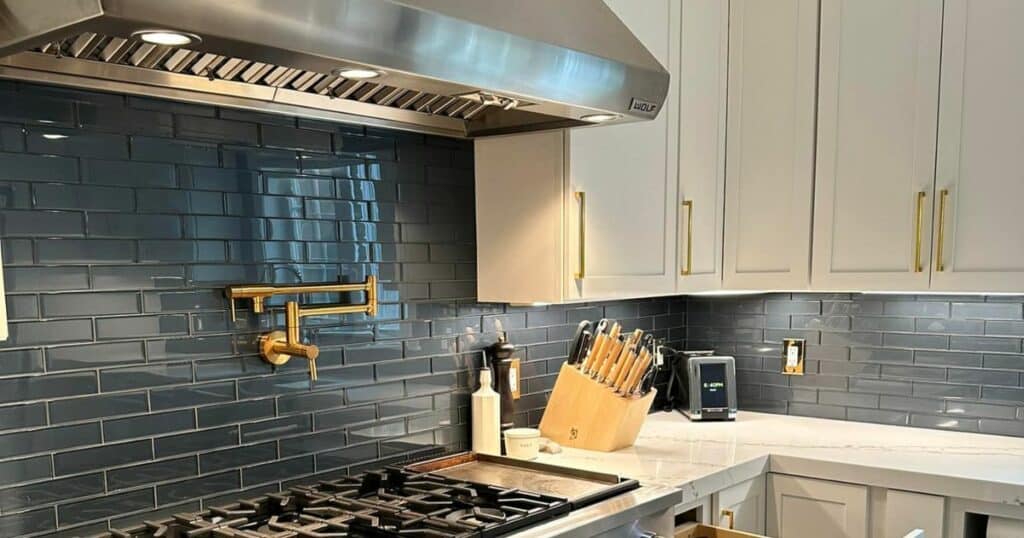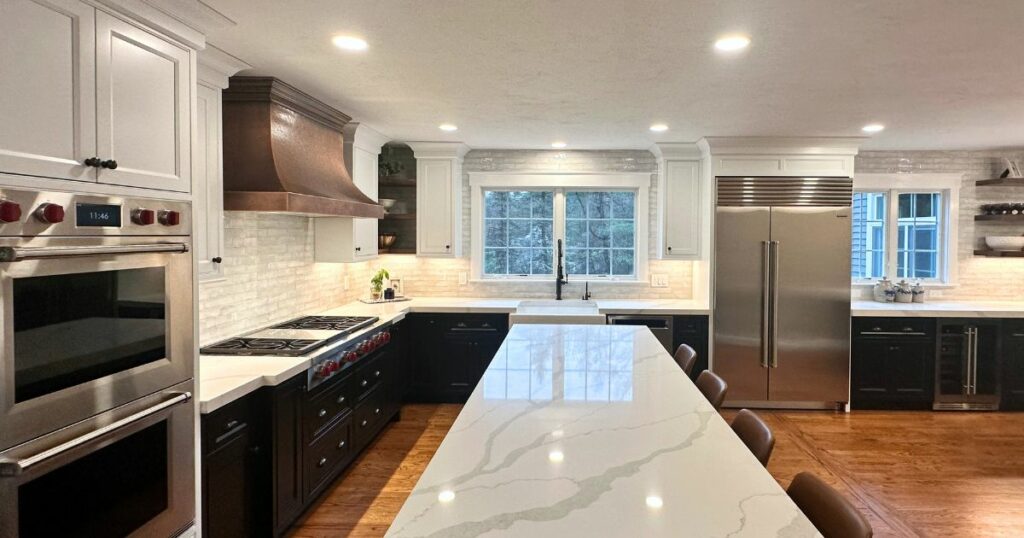Building your dream home is an exciting journey that allows you to bring your unique vision to life. Here’s a quick rundown to get you started:
Creating a custom home offers many benefits compared to buying a pre-built house. You have the freedom to design every aspect of your home, ensuring it fits your lifestyle perfectly. From selecting the perfect lot to deciding on the architectural style, every detail can be custom to your preferences.
At Bonsai Builders, we understand that building your dream home is a significant investment, both emotionally and financially. Our personalized approach ensures your home reflects your personality while maintaining high standards of craftsmanship and energy efficiency.
Staying involved during the construction process is crucial to ensure the project adheres to specifications and mitigates potential issues. We are committed to making the process seamless and enjoyable for you.

Table of Contents
Step 1: Determine Your Budget
Building your dream home starts with one crucial step: determining a realistic budget. Without a clear budget, your dream can quickly become a financial nightmare.
Budget Planning
First, you need to figure out how much you can spend. Accurate budgeting for various expenses related to building a new house, including labor, materials, and additional design elements, is crucial. According to the National Association of Home Builders, the median price of building a new home is around $290,000. However, this number can vary widely.
Cost estimates should include:
- Lot price: This can vary depending on location.
- Labor costs: Skilled labor is essential but can be expensive.
- Permits: Necessary for legal compliance.
- Design fees: If you hire an architect or designer.
- Materials: Choices here can significantly affect your budget.
Cost Per Square Foot
For a more detailed estimate, consider the cost per square foot:
- Standard homes: $100 to $200 per square foot.
- Luxury homes: $200 to $500 per square foot.
These figures don’t include the price for the lot, labor, permits, design fees, or materials. So, your actual costs can be higher.
Factors Influencing Costs
Several factors can influence the total cost:
- Location: Building in a high-demand area will cost more.
- Materials: High-end materials will increase your budget.
- Labor: Skilled labor is essential but can be costly.
- Permits and Fees: These are necessary and can add up quickly.
Professional Consultation
Consulting professionals like home builders, architects, and real estate agents can help you get a better understanding of costs.
Example: In Hudson, the cost to build a home ranges from $250 to $500 per square foot. Consulting a professional can provide a detailed cost breakdown based on your specific needs.
Next, we’ll guide you through finding the right lender to finance your dream home.
Step 2: Find the Right Lender

Once you have your budget figured out, the next step in building your dream home is to find the right lender. Financing a custom home involves different loan types and higher interest rates, so it’s crucial to understand your options.
Construction Loans
A construction loan is a short-term loan used to cover the cost of building your home. These loans typically have higher interest rates because they are considered riskier. The reason is simple: the home doesn’t exist yet, so it can’t be used as collateral.
Key Points About Construction Loans:
- Short-term: Usually up to one year.
- High-interest rates: Due to increased risk.
- Incremental funding: Money is released in stages as the construction progresses.
- Interest-only payments: During the construction period, you only pay interest.
After construction is complete, you can convert the construction loan into a traditional mortgage or get a new loan to pay off the construction loan.
Land Loans
If you need to purchase land before building, you might consider a land loan. There are two main types: raw land loans and improved land loans.
Raw Land Loans: For undeveloped land without utilities like water or electricity. These are riskier and come with higher interest rates and larger down payment requirements.
Improved Land Loans: For land with access to utilities and roads. These are less risky and usually have better terms. An improved land loan generally requires a larger down payment and good credit ratings due to the lack of collateral.
Key Points About Land Loans:
- Higher down payments: Often 20% to 50%.
- Good credit rating: Essential for approval.
- Higher interest rates: Especially for raw land loans.
Understanding Collateral and Down Payments
Because construction and land loans are riskier, lenders require substantial down payments. Typically, you’ll need at least a 20% to 25% down payment for a construction loan. This shows the lender that you’re serious and reduces their risk.
Example: If your construction project costs $300,000, you might need a down payment of $60,000 to $75,000.
Importance of a Good Credit Rating
Your credit rating plays a significant role in getting approved for a loan and securing favorable terms. A higher credit score can help you get lower interest rates and better loan conditions.
Real Estate Lending Options
When exploring financing options, it’s essential to compare different lenders. Here are a few types of loans you might consider:
- Traditional Mortgages: Not suitable for construction but can be used after the home is built.
- Bridge Loans: Short-term loans that help you buy a new property before selling your current one. They typically have high-interest rates.
- Home Equity Line of Credit (HELOC): If you have significant equity in your current home, you can borrow against it. These generally have lower rates than bridge loans.
- Borrowing Against Your 401K: This can be a last resort, as it has strict repayment terms and potential penalties.
Tips for Finding the Right Lender
- Research and Compare: Look at different lenders, including banks, credit unions, and online lenders. Compare their interest rates, terms, and fees.
- Seek Recommendations: Talk to real estate professionals, friends, or family who have experience with home construction loans.
- Get Pre-Approved: This gives you a clear idea of your budget and shows sellers you’re a serious buyer.
Example: In a case study, a family in Texas used a combination of a construction loan and a HELOC to build their custom home. They saved on interest by using the HELOC for initial expenses and then switched to a construction loan as the project progressed.
Next, we’ll discuss managing your expectations to ensure your dream home stays within your budget.
Step 3: Manage Your Expectations

Building your dream home can be exciting, but manage your expectations to avoid disappointment and stay within your budget.
Realistic Planning
Start by listing every feature you want in your new home. Individuals can take on simple projects themselves with the right understanding of design principles and building codes when designing their own house. Dream big, but be prepared to face reality when you see the prices. For example, hardwood floors and granite countertops are popular choices, but they come with a hefty price tag.
Budget Constraints
Your budget will dictate what you can and cannot include in your home. Be honest about your financial limits and prioritize essential features over luxury items.
Feature Concessions
You may need to make some concessions to stay within your budget. Decide which features are must-haves and which can wait. For instance, you might choose laminate flooring now and upgrade to hardwood later.
Influences from Pinterest and Social Media
Social media platforms like Pinterest and Instagram are full of #housegoals that can make you want everything you see. While these platforms are great for inspiration, they can also set unrealistic expectations.
Tip: Use these platforms to gather ideas but always cross-check prices and practicality.
Expert Advice
It helps to have the right people in place who can guide you. Builders, architects, and real estate agents can tell you what’s worth the investment and what’s mostly hype.
Quote: “It’s fun to list out every attribute you want in a new home, but reality sets in when you see the list on paper – and the prices.” – Bonsai Builders
Step 4: Assemble Your Dream Team
Building your dream home is a collaborative effort. You need a team of experts to bring your vision to life. Here’s how to assemble your dream team:
Home Builder Selection
Start by selecting a reliable home builder from a list of reputable builders with a strong reputation and experience in custom homes.
Tip: Check online reviews and ask for references. A good builder should have positive feedback from past clients.
Architect
An architect is crucial for designing your home. They translate your ideas into practical blueprints.
Fact: According to Duo Dickinson, an architect in Madison, Connecticut, “If you find the right people, building a house is one of the great joys in life.”
Advice: Hire an architect before buying the land. They can help assess the lot’s suitability for building and maximize its potential.
Real Estate Agent
A real estate agent can help you find the perfect lot for your home. They have access to listings and can negotiate better deals.
Tip: Choose an agent who understands your needs and has experience with custom home projects.
Example: A family in North Carolina worked with a real estate agent who specialized in custom home lots. The agent found a lot with an excellent view and good utility access.
Landscape Architect
A landscape architect can improve your yard’s appeal and functionality. They design outdoor spaces that complement your home.
Advice: Involve your builder in the lot selection process. They can identify potential issues like flood risks or unsuitable slopes.
Builder Experience, Licensing, and Insurance
Ensure your builder has the necessary experience, licensing, and insurance. This protects you from potential issues during construction.
Fact: Verify licenses and insurance coverage before signing a contract. This ensures your builder is qualified and reduces your liability.
Informal Interview
Meet your potential builder for an informal interview. Ask about their process, preferences, and how they handle budgeting and estimation.
Questions to Ask:
- How do you manage project timelines?
- Do you work with interior designers and architects?
- Can you provide a ballpark ETA for the project?
Project Timelines
Understanding the timeline for your project is crucial. On average, it takes eight months to build a home, according to the U.S. Census Bureau.
Fact: Delays can occur due to supply shortages, weather, and other factors. Discuss these possibilities with your builder.
Builder-Architect Collaboration
A seamless collaboration between your builder and architect is essential. Many builders have in-house architects, which simplifies communication and ensures the design fits your budget.
Quote: “Having a professional helps you understand the property you are buying.” – Elissa Morgante, Morgante Wilson Architects
Step 5: Choose the Perfect Lot

Choosing the right lot for your dream home is just as important as the home itself. The location, property history, and physical characteristics of the lot can significantly impact your home’s value and livability. Here’s how to make the best choice:
Selecting the perfect lot requires careful consideration and expert advice. Start by choosing a location with easy access to amenities, a positive community vibe, and an understanding of future developments that could impact the area. Research the property’s history, including past sale prices and previous developments, to determine a fair offer.
Step 6: Decide on Architectural Design
Designing your dream home is where the fun truly begins. This step allows you to visualize your future living space and bring your ideas to life. Here’s how to get started:
Choose an Architectural Style
The first decision is selecting an architectural style that resonates with you. Some popular styles include:
- Modern: Characterized by clean lines, large windows, and open spaces. Ideal for those who prefer minimalism and contemporary aesthetics.
- Craftsman: Known for its handcrafted woodwork, built-in furniture, and a cozy, homey feel. Perfect for those who appreciate artistry and detail.
- Farmhouse: Features large porches, gabled roofs, and a rustic charm. Great for those who love a blend of traditional and modern elements.
- Traditional: Emphasizes classic designs, symmetry, and rich details. Suitable for those who prefer timeless elegance.
Tip: Drive through neighborhoods or browse real estate websites to see which styles catch your eye.
Explore Floor Plan Options
Once you have chosen a style, it’s time to think about the floor plan. The floor plan determines the layout and flow of your home.
Builder-Provided Plans
Many builders offer pre-designed plans that can be customized to fit your needs. This can save time and ensure that the design is feasible within your budget.
Advantages:
- Cost-effective: Pre-designed plans are usually less expensive than custom designs.
- Faster approval: These plans often meet local building codes, speeding up the permit process.
- Proven designs: These plans have been built before, reducing the risk of unforeseen issues.
Note: Always review the plans with your builder to ensure they meet your specific requirements.
Interior Design and Custom Features
Your home’s interior design is just as important as its exterior. Work with an interior designer to create a space that reflects your personality and lifestyle.
Consult with Experts
Throughout this process, lean on the expertise of your architect and builder. They can provide valuable insights and help you make informed decisions.
Quote: “An architect should be able to fly through a lot of ideas quickly with you,” says Elissa Morgante, a partner at Morgante Wilson Architects in Chicago.
By carefully considering your architectural style, floor plan, and interior design, you’ll create a home that’s not only beautiful but also perfectly custom to your needs. Next, we’ll discuss how to create a realistic timeline for your project.
Step 7: Create a Realistic Timeline

Building your dream home is a journey, and it’s crucial to set a realistic timeline to avoid unnecessary stress and surprises. According to the U.S. Census Bureau, it takes an average of eight months to build a new home. This includes obtaining permits, construction, inspections, and dealing with inevitable delays.
Understand the Timeline
Eight months is a general guideline. The actual time can vary based on several factors:
- Permits and Approvals: Acquiring the necessary permits can be time-consuming. Ensure you apply early to avoid delays.
- Construction Phases: From laying the foundation to the final touches, each phase has its own timeline.
- Inspections: Regular inspections are required to ensure everything meets local building codes.
- Delays: Be prepared for unexpected delays due to weather, supply shortages, or other unforeseen issues.
Plan for Delays
Even the best plans can encounter hiccups. Bad weather, supply chain issues, and labor shortages can all cause delays. Building a buffer into your timeline can help manage these disruptions.
Simplify Your Floor Plan
The more custom features you add, the longer it will take to build. If time is a factor, consider a simpler floor plan. Complex designs with unique features and custom elements can extend the construction period.
Advice: Opt for a design that balances your needs and wants. A simpler plan can still be beautiful and functional.
Communicate Regularly
Stay in constant communication with your builder. Regular updates can help you stay informed about the progress and any potential issues.
Tip: Schedule weekly check-ins with your builder to review progress and address any concerns promptly.
Keep Things in Writing
Document all decisions and changes in writing. This helps keep everyone on the same page and can prevent misunderstandings.
Be Flexible
Flexibility is key. Be prepared to adapt if unexpected issues arise. Whether it’s a delay due to weather or a change in material availability, being flexible will help you steer these challenges smoothly.
Quote: “Construction projects often encounter unexpected challenges. Whether it’s a delay due to weather or a change in material availability, be prepared to adapt,” advises H. Dale Contant, president of Atlanta Design & Build.
By creating a realistic timeline and planning for potential delays, you can ensure a smoother building process.
Conclusion
Building your dream home is not just about constructing walls and a roof; it’s about creating a space where memories will be made. It’s an exciting journey that culminates in a unique, personalized home custom to your lifestyle and tastes.
Bonsai Builders: Your Partner in Luxury Home Construction
At Bonsai Builders, we pride ourselves on delivering master craftsmanship and exquisite designs. With over 26 years of experience, we have the expertise to turn your dream home into a reality. Our attention to detail and commitment to quality ensure that every aspect of your home is flawlessly executed.
Luxury Home Construction in Massachusetts
Massachusetts offers a rich history and diverse landscapes, making it an ideal location for building your dream home. Whether you’re looking for a modern masterpiece or a traditional estate, Bonsai Builders is equipped to deliver the best in luxury home construction.
Ready to start your journey? Contact us today and let’s turn your dream into reality, one step at a time.
By choosing Bonsai Builders, you’re not just building a house; you’re creating a home that reflects your personality and lifestyle. So, let’s get started on making your dream home a reality.
Frequently Asked Questions about Building Your Dream Home
Is it cheaper to build your dream house?
Building your dream house can be more expensive than buying an existing one, but it depends on several factors. According to the National Association of Home Builders, the median price for building a home from scratch is around $290,000. However, custom homes often cost more due to personalized features and higher-quality materials.
Key Factors Affecting Cost:
- Labor Costs: Labor is a significant part of your budget. Custom homes generally require specialized skills, driving up labor costs.
- Home Size: Larger homes cost more to build. The cost per square foot can range from $150 to $250, but luxury homes can go up to $550 per square foot.
- Finishes: High-end finishes like hardwood floors and granite countertops can add significantly to the cost.
Example: A family in Massachusetts found that their custom-built home, with luxury features, cost them around $450,000, compared to $300,000 for a similar-sized pre-built home in the same area.
How to build the home of your dreams?
Building your dream home involves careful planning and coordination. Here are the essential steps:
- Budget: Determine how much you can afford to spend. Include costs for permits, materials, labor, and unexpected expenses. Bonsai Builders suggests having a bit of wiggle room in your budget to handle any surprises.
- Location: Choose a location that suits your lifestyle. Consider proximity to amenities like schools, shopping centers, and medical facilities.
- Architect: Hiring an architect can help you design a home that meets your needs and fits your budget. Some builders offer in-house architects, which can save money.
- Financing: Secure a construction loan or land loan. A strong credit score can help you get better loan terms.
- Permits: Obtain all necessary permits before starting construction to avoid delays.
- Contractor: Select a reputable contractor with experience in building custom homes. Check their licensing, insurance, and references.
- Foundation and Structure: Ensure your foundation and structural elements are built to last. Skimping on these can lead to costly repairs later.
What to consider when building a dream house?
When building your dream home, keep the following in mind:
- Location: The location of your home can affect everything from your daily commute to your property value. Research the area thoroughly before making a decision.
- Land Selection: Choose a lot that fits your needs. Consider factors like flood risk, lot slope, and tree locations.
- Architectural Style: Decide on a style that reflects your taste. Whether it’s modern, farmhouse, or traditional, make sure it aligns with your vision.
- Functional Design: Think about how you live. Do you need a home office, a playroom for the kids, or an entertainment room? Design with your lifestyle in mind.
- Builder Selection: Choose a builder who understands your vision and has a good track record.
- Energy Efficiency: Incorporate energy-efficient features and smart home technology to save on long-term costs. Proper insulation, energy-efficient windows, and HVAC systems can make a big difference.
By considering these factors and planning carefully, you can build a home that meets your needs and stands the test of time.
Our Content
Our experienced contractors and design specialists carefully review and edit all content to ensure it meets our high standards for quality and accuracy. We do this to provide our readers with content that is accurate, complete, reliable, and up-to-date. Bonsai Builders, located in Sutton, Massachusetts is a trusted neighborhood building source across Massachusetts for kitchen remodeling, fence boards, and more with over 26 years of experience and over 125 jobs completed.
Bonsai Builders has renovated many split-level home kitchens across Massachusetts. Bonsai Builders is selected as best of Houzz year after year further showing their expertise and trust among homeowners in Massachusetts.

